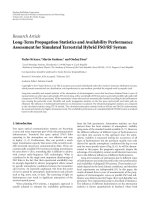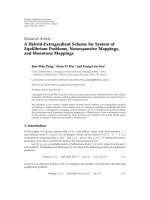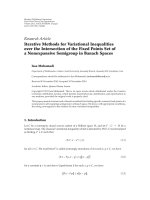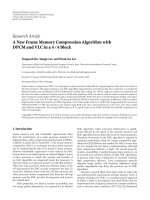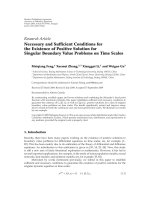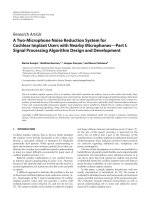Báo cáo hóa học: "Research Article A Modified Run-Length Coding towards the Realization of a RRO-NRDPWT-Based ECG Data Compression System" pdf
Bạn đang xem bản rút gọn của tài liệu. Xem và tải ngay bản đầy đủ của tài liệu tại đây (956.69 KB, 8 trang )
Hindawi Publishing Corporation
EURASIP Journal on Advances in Signal Pr ocessing
Volume 2011, Article ID 703752, 8 pages
doi:10.1155/2011/703752
Research Ar ticle
A Modified Run-Length Coding towards the Realization of
a RRO-NRDPWT-Based ECG Data Compression System
Hsieh-Wei Lee, King-Chu Hung, Tsung-Ching Wu, and Cheng-Tung Ku
Department of Computer and Communication Engineering, National Kaohsiung First University of Science and Te chnology, Taiwan
Correspondence should be addressed to Hsieh-Wei Lee,
Received 9 November 2010; Revised 1 March 2011; Accepted 4 March 2011
Academic Editor: Patrick Oonincx
Copyright © 2011 Hsieh-Wei Lee et al. This is an open access article distributed under the Creative Commons Attribution License,
which permits unrestricted use, distribution, and reproduction in any medium, provided the original work is properly cited.
The wavelet-based approach that combines a reversible round-off nonrecursive discrete periodized wavelet transform (RRO-
NRDPWT) and the set partitioning in hierarchical trees (SPIHT) scheme is an efficient ECG data compression. However, this
RRO-NRDPWT-based system suffers from the high complexity of the S PIHT scheme during realization. In this paper, a modified
run-length coding (MRLC) algorithm i s proposed towards the realization of a RRO-NRDPWT-based ECG data compression
system. The MRLC with its regularity and low computational complexity is suitable for hardware implementation, but at a cost of
compression performance. This sacrifice is compensated by an efficient quantization scheme. By using the MIT-BIH arrhythmia
database, the experimental results s how that the proposed scheme can compete with the SPIHT scheme for a compression ratio
(CR) greater than 8. Hardware simulations are taken using both the Verilog logic simulator with Cadence design platform, and a
Xilinx FPGA EP2C35F672C6.
1. Introduction
An electrocardiogram (ECG) is a non-invasive modality that
senses the electric action of heart motion from the surface
of a body. Since the heart is a three-dimensional organ,
heart disease diagnosis usually requires the use of several
ECG signals sensed at various positions around the heart.
A typical requirement for heart disease diagnosis and health
care is a long-term record of 12-lead ECG signals [1]. To this
end, portable E CG sensing systems associated with wireless
data transmission have been developed for ambulatory
monitoring and recording. ECG data compression is crucial
for creating a reduction in power consumption, efficient data
transmission, and storage [2, 3].
In many ECG data compression methods, wavelet-
based approaches w ith high compression performance have
attracted much attention from researchers [4–7]. These
approaches that attempt to o ptimize the compromise
between CR and distortion all employ the lossy compression
method in which the percentage root-mean-square differ-
ence (PRD) is usually used as the distortion measure. Lossy
ECG data compression can be meaningful only if clinical
information and reconstruction quality can be preserved and
maintained. Quality maintenance is usually time consuming
due to the recursive process of compression and reconstruc-
tion error measurement. For this reason, realizing wavelet-
based data compression with hardware is required to create
real-time recoding of multilead ECG signals. In realization,
high compression performance, low complexity, and rapid
convergence in reconstruction quality control are important
considerations.
With low complexity, threshold-based schemes [2, 5–7]
are one optimal option. The SPIHT scheme incorporating
thresholding into tree coding provides progressive mode
ECG compression [2]. In [5], thresholding was first used
to maintain a fixed percentage of wavelet coefficients at
zeros followed by an entropy coding. The filter bank-
basedmethod[6] uses target PRD as t he criterion for
threshold value determination. Recently, a method based on
orthogonal wavelet filters was proposed for efficient ECG
data compression [7]. This approach combines nonrecursive
1-D discrete periodized wavelet transform (1-D NRDPWT)
and a reversible round-off linear transformation (RROLT)
theorem in order to eliminate the word-length-growth
effect. This DPWT, referred to as the 1-D RRO-NRDPWT,
facilitates a real-time process and a design of linear distortion
2 EURASIP Journal on Advances in Signal Processing
control. The RRO-NRDPWT-based ECG data compression
also applies the SPIHT scheme for the coding of quantized
wavelet coefficients.
The SPIHT scheme can be very efficient for data inherent
in hierarchical self similarities. However, this scheme exploits
the self similarities in terms of dynamic data structures
that will impose practical limitation on hardware imple-
mentation [8 –12], especially for large-size data sequences.
Inordertosavethethreeintermediatedatasets,listof
insignificant sets (LIS), list of insignificant pix els (LIP),
and list of significant pixels (LSP), the SPIHT encoder
should reserve a buffer size of 4.5 log
2
L bits where L is
the image width. This buffer size is even larger than the
image itself [9]. A simulation using Xilinx Virtex 2000E
FPGA [10]showsthatforencodinga16
× 16 image, SPIHT
scheme needs 61531 gates. The RRO-NRDPWT-based ECG
data compression system was also simulated on the Xilinx
FPGA, EP2C35F672C6 [12]. The system is composed of
three functional blocks RRO-NRDPWT, quantization, and
the SPIHT coding in which the RRO-NRDPWT block is
performed with 21-bit precision. The evaluation result shows
that for 1024 ECG samples, the first two blocks require
6254 and 2383 logic elements, respectively. On the other
hand, for only 32 ECG samples, the SPIHT block will need
25480 logic elements, which occupy (254180/33216)
× 100 =
76.7(%) of total logic elements. Note that with the limitation
of EP2C35F672C6, we cannot evaluate 64-sample case or
larger.
In this paper, towards the realization of RRO-NRDPWT-
based ECG data compression system, a modified run-length
coding (MRLC) method is presented in place of the SPIHT
scheme. The MRLC can effectively reduce computational
complexity at the cost of compression performance. For
compensation, a modified quantization scheme with approx-
imate linear distortion is presented for improving compres-
sion performance. Several experiments are also taken by
using the MIT - BIH arrhythmia database [13].
The rest of this paper is organized as follows. The
nonlinear quantization scheme with the approximate linear
distortion characteristic is developed in Section 2.The
proposed ECG data compression scheme is described in
Section 3.InSection 4, several experiments in ECG data
compression are evaluated. The analysis and synthesis
report of the proposed MRLC architecture are presented
anddemonstratedinSection 5. Finally, the conclusion is
provided in Section 6.
2. A Nonlinear Quantization Scheme
with Approximately Linear
Distort ion Characteristics
The RRO-NRDPWT is a nonrecursive 1-D D PWT that can
achieve fixed-point computation in terms of error propaga-
tion resistance and a uniform distribution of subband error.
The two mechanisms facilitate the significant normalization
of subband data and a quantization scheme design with
linear distortion characteristics.
Given a negative integer J with N
= 2
−J
,whereN denotes
the number of original sampled data of a finite 1-D signal.
Let d
∗
j
for J<j≤ 0 be a vector encompassing the reversible
wavelet coefficients of the jth level. The quantization process
can be defined as
s
∗
0
= tr
s
∗
0
b
DC
,
d
∗
j
= tr
d
∗
j
c
j
,(1)
where tr(d
∗
j
) denotes the truncation process that truncates
each element of d
∗
j
to an integer, and b
DC
and c
j
are the
terminate and jth levels’ quantization scales, respectively. In
the inverse quantization process, each retrieved datum will
be compensated by half of the quantization scale, namely
s
∗
0
= b
DC
s
∗
0
+0.5 · sign
s
∗
0
,
d
∗
j
= c
j
d
∗
j
+0.5 · sign
d
∗
j
,
(2)
where sign(
d
∗
j
) denotes the sign vector of
d
∗
j
.Forthe
determination of quantization scales, we define c
j
as
c
j
=
cp
j
SNF
j
,(3)
where SNF
j
= max
l
{
2
− j+1
k=2
− j
|a
kl
|} is a significant normal-
ization factor and cp[ j] are adjustable parameters and a
kl
is
the kth row and lth column element of the inverse matrix of
RRO-NRDPWT [7].
Equation (2) shows that for each segment (N
=
1024 ECG samples), the reconstruction requires 11 cp[ j]
including b
DC
.Itwillbeefficient to generate cp[ j]with
a single variable. To this end, curve fitting is one simple
approach. The cp[ j] design process is described in the
following.
Step 1. Find seven sets of cp[j], j
= 0, 1, , 10 correspond-
ing to different PRD values ranging from 0 to 7%.
Step 2. Introduce 11 quadratic equations for fitting the 11
cp[ j] curves with sing l e control variable QF. The coefficients
of 11 quadratic equations are found by least square error
criterion.
In Step 1,anexhaustivesearchofcp[j]foreachPRD
valueshouldbeperformedinan11-Dspace.Insolarge
a space, it is impossible to find a global solution. Instead,
we optimize the local solution based on the quantization
scheme given in [3]. For minimizing the search area, the
condition cp[i] < cp[ j], for i>jis also applied. In Step 2,
the seven cp[j]valuesforeachj will be fitted with a quadratic
EURASIP Journal on Advances in Sig nal Processing 3
0
5
10
15
20
25
30
35
0 4 8 121620242832
QF
PRD (%)
Figure 1: The PRD-QF curves of 48 ECG signals derived by the
modified quantization scheme.
function in which the range of PRD is fitted by 16 QF values.
One locally optimal solution is given in the following:
cp
[
0
]
= b
DC
= 0.1+
q
10
,cp
[
−1
]
= 0.1+
q
7
,
cp
[
−2
]
= 0.4+
q
4
,cp
[
−3
]
= 0.5+
q
2
,
cp
j
=
0.5+
q
2
·
(
1.2
)
−( j+4)
−
j +3
·
q
2
for j
=−4, −5, , J +1,
(4)
where q
= 10 · ((QF + 1)/16)
2
.In(4), QF can be an available
variable for desired PRD and CR control.
In order to explore the linear control performance of
QF, all 48 ECG signals recorded in the MIT-BIH ar rhythmia
database were investigated. Each signal contains about a 15
minutes length of sampled data. The measurement results are
depicted in Figure 1. Figure 1 reveals that an approximately
linear relationship between PRD and QF can be obtained
for all signals with different gradients. The linear distortion
characteristic will facilitate a rapid reconstruction quality
control.
3. The Proposed ECG Data
Compression Scheme with the Modified
Run-Length Coding
The proposed RRO-NRDPWT-based ECG data compression
scheme with the modified run-length coding is shown in
Figure 2. In the encoding process, the 1-D RRO-NRDPWT
first produces reversible wavelet coefficients d
∗
j
.From(1),
for a given QF value, we can obtain quantized data
d
∗
j
.
The QF and these quantized data will be losslessly encoded
with a differential pulse-code modulation (DPCM) and the
modified run-length method, respectively. The algorithm of
modified run length coding is described in Algorithm 1.
Example 1 (neglecting sign bit representation). Let Block
2
= [31200000000070000]; it can be found that
nmax
2
=log
2
(12) +1 = 4 and there are two zero
segments (i.e., arg 2
= 9and4).Bothtwozerosegments
will be represented with Zbit
=log
2
(z
2
− 1)=4bits,
that is, (arg 2
− 1)
2
= (1000)
2
and ( 0011)
2
). Consequently,
the output sequence of Block
2
is given in Table 3.
In comparison with a specific run-length coding [14],
36 bits are required for Example 1. The proposed method
needs less bits. For representation with sign bits, an example
is given as follows.
Example 2 (considering sign bit representation). Let Block
2
=
[3 − 12 −70000000000000].Bothnmax
2
and Zbit
are equal to 4. The output sequence will be in Ta b le 4 ,where
the last t hree bits are used to represent the signed coefficients
3,
−12, and −7, respectively. Note that the eight nmax
i
, i =
0, , 7, represented with the same word length will b e put at
the beginning of output sequence, that is, a MRLC codec.
The MRLC codec can be decoded real-time block by
block. The decoding process of MRLC is described in
Algorithm 2.
After decoding, the reconstructed data,
S
J
can be
obtained directly from (2) where the quantization scales are
generated by applying QF into (3)and(4).
4. Experimental Results
For hardware realization, complexity reduction usually leads
to a sacrifice of compression performance. Several exper-
iments were made in order to evaluate the compression
performance of the MRLC-based approach. The original
data compression scheme of [3]andtheproposedscheme
are referred to as N RDPWT-6r and NRDPWT-MRLC,
respectively. A dataset comprising 11 ECG signals: 100, 101,
102, 103, 107, 109, 111, 115, 117, 118, and 119, recorded in
the MIT-BIH arrhythmia database (360 samples/sec a nd 11
bit resolution) was built for the test. With 11 bit resolution,
the word length of nmax
i
is defined as WL(nmax
i
) = 4.
Each signal contains about a 10-min length of sampled
data. Each segment involves 1024 samples of ECG data. The
experimental result is shown in Ta b le 1 where each value
denotes the average PRD for a specified CR. The value of
PRD is defined by
PRD
(
%
)
=
N
i
=1
s
J
[
i
]
− s
J
[
i
]
2
N
i
=1
s
J
[
i
]
2
∗ 100, (5)
where
s
J
[i]ands
J
[i] denote the reconstructed and original
signals, respectively. Note that the PRD algorithm acts on
a zero-mean signal. Since a baseline o f 1024 is added for
the storage purposed in the MIT-BIH arrhythmia database,
so a level of 1024 is removed from each sample before
processing. Table 1 shows the PRD-CR performances of
several ECG data compression schemes including SPIHT
4 EURASIP Journal on Advances in Signal Processing
Initialization: Divide the quantized wavelet coefficients into k encoding blocks.
For N
= 1024, k is defined as k = 8and
Block
0
= {c
0
, d
0
, d
−1
, d
−2
},Block
1
= {d
−3
},
Block
2
= {d
−4
},Block
3
= {d
−5
},
Block
4
= d
−6
,Block
5
= d
−7
,
Block
6
= d
−8
,Block
7
= d
−9
,
where the lengths of block, z
i
for i = 0, , k − 1, are 8, 8, 16, 32, 64, 128, 256, and 512 respectively.
Parameter definition:Letcoe
i, j
denote the jth coefficient in Block
i
.Definenmax
i
= WL(arg1) and
Zbit
= WL(arg2) be the word length of arg1 and arg2 that denote the maximum absolute
value of coe
i, j
and the number of c onsecutive zeros, respectively. For saving the coding result
of each block, two registers, RL
set
i
and sig n set
i
,
are also introduced with WL(RL
set
i
) = (nmax
i
+ Zbit) · z
i
and WL(sign set
i
) = z
i
.
Step 1: Find the nmax
i
of Block
i
.
for i
= 0, , k − 1arg1= 0;
for j
= 0, , z
i
− 1
if arg 1 <abs(coe
i, j
)
arg 1
= abs(coe
i, j
);
end
if arg 1
== 0
nmax
i
= 0;
else
nmax
i
=log
2
(arg 1) +1;
end.
Step 2: Encode the elements of each block.
for i
= 0, , k − 1
if nmax
i
== 0
Skip this block;
else
for j
= 0, , z
i
− 1
if coe
i, j
/
= 0
{save (abs(coe
i, j
))
2
with nmax
i
bits in RL set
i
and one sign bit in sign set
i
;}
else
{save (0)
2
with nmax
i
bits in RL set
i
; Count the number of consecutive zeros to be arg2
and save (arg2
− 1)
2
with Zbit bits in RL set
i
; j = j +arg2;}
end
end.
Step 3: Output sequence in the order of [nmax
i=0:k−1,
,RLset
i=0:k−1,
sign set
i=0:k−1
].
Algorithm 1
[2], NRDPWT-6
R
[3], NRDPWT-6
T
[15], and NRDPWT-
MRLC where k denotes the number of blocks. For k
=
1, Block
0
={c
0
,d
0
,d
−1
, ,d
−9
};fork = 2, Block
0
=
{
c
0
,d
0
,d
−1
, ,d
−8
}, and Block
1
={d
−9
},andsoforth.For
the five partition modes (i.e., k
= 7 to 11), their compression
performances are very close, and k
= 8 performs best.
Tabl e 1,alsoshowsthatforCR> 8, the NRDPWT-MRLC
(k
= 8) can be competitive with the SPIHT scheme [2].
For CR < 8, the average PRD difference between NRDPWT-
6
R
and NRDPWT-MRLC (k = 8) can be limited to wit hin
1.5%.
For practical application, preserving clinical information
is a crucial requirement for system development of ECG data
compression. A quantitative relation between distortion and
the degree of clinical information preservation was evaluated
in [16]. The evaluation showed that reproduced ECG
waveforms at specified PRDs of 7% and 9% were graded as
“no diagnostic information lost” and “clinically acceptable”,
respectively. A reproduced waveforms at a PRD of 13% was
“notably degenerated in some Q-waves and ST-segments”.
The experimental results show that the proposed system
can be competitive with other wavelet-based approaches for
CR > 8 and feasible for well preserving clinical information
that includes amplitude and duration (PRD
7% for CR =
20).
Several compression results from the NRDPWT-MRLC
(k
= 8) scheme are demonstrated in Figure 3 in which each
signal involves first 2048 samples. Figure 3(a) shows the ECG
signal of record 117 with a nice waveform. For this signal,
the PRD can be lower than 3% when CR reaches 22.2. The
signal from record 232 with a distorted and noisy waveform
is shown in Figure 3(b) where the reconstruction error is
unobservable. The ECG signal shown in Figure 3(c) is record
109 with a waveform containing a wandering baseline and
slight noise coupling. This signal has poor PRD due to the
smoothing effect of the quantization process. However, the
EURASIP Journal on Advances in Sig nal Processing 5
Step 1: Get nmax
i
, i = 0, , k − 1.
Step 2: Decode the elements of each blocks.
for i
= 0, , k − 1
if nmax
i
== 0
Assign all coefficients of Block
i
to be zeros.
else
{for j = 0, ,z
i
− 1
Get nmax
i
bits to be arg 1;
if arg 1
/
= 0
Decode arg 1 to be abs(coe
i, j
);
else
{Decode arg 1 to be zero;
Get Zbit bits to be arg2-1 and decode arg2 to be the number of zeros;
j
= j +arg2;}
end
}
end.
Step 3: Correct the sign of nonzero coefficients using the s ign bits.
Algorithm 2
QF
Encoding process
Reversible
round-off 1-D
NRDPWT
Nonlinear
quantization
process
Modified
run length
encoding
Inverse
reversible
round-off 1-D
NRDPWT
Inverse
quantization
process
Modified
run length
decoding
Decoding process
˜
d
∗
j
˜
d
∗
j
^
d
∗
j
d
∗
j
Reconstructed
ECG data
^
S
∗
J
Original
ECG data
S
J
Figure 2: The RRO-NRDPWT-based ECG data compression scheme with modified r un length coding.
Table 1: PRD (%) comparison of the three methods SPIHT [2], NRDPWT-6
R
[3], NRDPWT-6
T
[15], and NRDPWT-MRLC.
Compression method
CR
4 :1 5 : 1 6 : 1 8 :1 10 :1 12 : 1 14 : 1 16 : 1 18 : 1 20 :1
SPIHT [2] 1.19 1.56 — 2.46 2.96 3.57 — 4.85 — 6.49
NRDPWT -6
R
[3] 1.03 1.36 1.65 2.19 2.64 3.11 3.66 4.29 5.00 5.72
NRDPWT -6
T
[15] 0.98 1.29 1.57 2.07 2.52 3.03 3.60 4.23 4.94 5.74
NRDPWT
MRLC (k = 1) 1.95 2.27 2.56 3.21 4 4.97 6.07 7.28 8.41 9.71
NRDPWT
MRLC (k = 2) 1.89 2.2 2.48 3.12 3.89 4.83 5.88 7.06 8.14 9.36
NRDPWT
MRLC (k = 3) 1.74 2.05 2.34 2.92 3.64 4.53 5.47 6.62 7.73 8.85
NRDPWT
MRLC (k = 4) 1.66 1.95 2.23 2.75 3.41 4.14 5.07 6.08 7.21 8.29
NRDPWT
MRLC (k = 5) 1.62 1.91 2.17 2.66 3.24 3.93 4.74 5.71 6.69 7.74
NRDPWT
MRLC (k = 6) 1.61 1.9 2.14 2.63 3.17 3.8 4.53 5.41 6.34 7.32
NRDPWT
MRLC (k = 7) 1.61 1.9 2.14 2.61 3.14 3.76 4.46 5.29 6.19 7.12
NRDPWT
MRLC (k = 8) 1.61 1.9 2.14 2.61 3.14 3.75 4.44 5.26 6.15 7.06
NRDPWT
MRLC (k = 9) 1.61 1.9 2.14 2.61 3.14 3.75 4.44 5.26 6.15 7.07
NRDPWT
MRLC (k = 10) 1.61 1.9 2.14 2.61 3.14 3.76 4.45 5.28 6.17 7.09
NRDPWT
MRLC (k = 11) 1.61 1.9 2.14 2.62 3.15 3.76 4.47 5.3 6.2 7.13
∗
Both two numbers of iteration were tested in our experiments. The contours generated by the two iterations are minor difference.
6 EURASIP Journal on Advances in Signal Processing
Reconstructed signal; QF = 6 (CR = 8.52, PRD = 1.11%)
Reconstructed signal; QF
= 10 (CR = 14.24, PRD = 1.86%)
Reconstructed signal; QF
= 15 (CR = 22.2, PRD = 2.6%)
200 400 600 800 1000 1200 1400 1600 1800 2000
200 400 600 800 1000 1200 1400 1600 1800 2000
200 400 600 800 1000 1200 1400 1600 1800 2000
200 400 600 800 1000 1200 1400 1600 1800 2000
Original signal MIT-BIH record: 117
600
800
1000
600
800
1000
600
800
1000
600
800
1000
(a) The original and reconstructed ECG signal of MIT-BIH record
117
200 400 600 800 1000 1200 1400 1600 1800 2000
200 400 600 800 1000 1200 1400 1600 1800 2000
200 400 600 800 1000 1200 1400 1600 1800 2000
200 400 600 800 1000 1200 1400 1600 1800 2000
Original signal MIT-BIH record: 232
900
1100
900
1100
900
1100
900
1100
Reconstructed signal; QF
= 6 (CR = 6.52, PRD = 4.7%)
Reconstructed signal; QF
= 10 (CR = 11.26, PRD = 8.94%)
Reconstructed signal; QF
= 15 (CR = 20.76, PRD = 14.44%)
(b) The original and reconstructed ECG signal of MIT-BIH record
232
200 400 600 800 1000 1200 1400 1600 1800 2000
200 400 600 800 1000 1200 1400 1600 1800 2000
200 400 600 800 1000 1200 1400 1600 1800 2000
200 400 600 800 1000 1200 1400 1600 1800 2000
Original signal MIT-BIH record: 109
800
1100
1200
800
1100
1200
800
1100
1200
800
1100
1200
Reconstructed signal; QF
= 6 (CR = 6.49, PRD = 1.67%)
Reconstructed signal; QF
= 10 (CR = 10.69, PRD = 2.76%)
Reconstructed signal; QF
= 15 (CR = 17.37, PRD = 4.53%)
(c) The original and reconstructed ECG signal of MIT-BIH record 109
Figure 3: The demonstrations of reconstructed signals with MIT-BIH record 117, 232, and 109.
Table 2: The synthesis report of the MRLC encoder with 8-level of Figure 4.
mem1 ∼ mem8 (1024 × 1 1-bit) barrel shifter ( 32-bit) other Total
Gate count 125188 388 6415 131991
Critical path 9.46 ns
wire
load model tsmc18 wl10
technology TSMC 0.18 µm
Table 3
0011 1100 0000 1000 0111 0000 0011
3129zeros74zerosTotal28bits
Table 4
0011 1100 0111 0000 1100 1 0 0
3 12 7 13 zeros sign bits total 23 bits
EURASIP Journal on Advances in Sig nal Processing 7
MRLC
Z bit
= 3
MRLC
Z bit
= 3
MRLC
Z bit
= 4
MRLC
Z bit
= 9
.
.
.
.
.
.
.
.
.
Packer
data
in data out
Mem1
Mem2
Mem3
Mem8
Find
nmax
1
Find
nmax
2
Find
nmax
3
Find
nmax
8
Figure 4: Block diagram of the MRLC encoder with k = 8.
Non-zero
coe
i, j
Zero
counter
Enable
OutIn
Packer
nmax
i
-bit value
+
1 bit sign
nmax
i
-bit 0 s
+
Z bit value
nmax
i
, Z bit
nmax
i
Figure 5: Circuit of the MRLC block shown in Figure 4.
clinical information, including the amplitude and duration,
can be preserved well.
5. Hardware Simulation
The block diagram of an MRLC encoding circuit is illustrated
in Figure 4 where k
= 8 is considered towing to its good
compression performance. For each segment, quantized
wavelet coefficients will be partitioned into 8 blocks which
will be saved in mem1
∼mem8, respectively. In the meantime,
the nmax
i
for each block will be determined. It should be
noted that once k is fixed, the WL(Zbit) for each block is
determined due to the regularity of block length.
As shown in Figure 5, the MRLC block consists of three
functional circuits, Non-zero coe
i, j
(NZc), zero counter
(ZC), and a packer. The NZc circuit will output a sign bit
and an absolute non-zero coefficient with nmax
i
bits. The
ZC circuit driven by the data coming from memi is used
to count t he number (denoted by arg2) of consecutive zero
coefficients. The two circuits with opposite functions are also
optioned by the data coming from memi. The output of the
ZC circuit involves an nmax
i
-bit zero and arg2-1 where arg2-
1 is represented with Zbit bits. The packer is used to arrange
the outputs of NZc and ZC circuits in sequence.
Because the data in different blocks (memi)willbe
encoded with different word lengths, the packer of Figure 4
will pack the outputs of MRLC blocks in order to generate
a 32-bit bitstream. This p rocess is performed by controlling
a 32-bit barrel shifter. The MRLC encoder with k
=
8showninFigure 4 is simulated in order to validate
its functionality. The simulation was performed using a
Verilog logic simulator with Cadence design platform. The
synthesis result was reported by synopsys logic simulator
using TSMC/Artisan 0.18 µm technology. The simulation
chose tsmc18
wl10 in the slow library as the wire load
model. The H/W specification is summarized in Tab l e 2.
In this simulation, mem1
∼ mem8 was implemented with
logic instead of a macro cell p rovided by the memory
compiler of the ASIC vendor. The total gate count of the
MRLC encoder is 131991 where memory and the barrel
shifter occupy 125188 and 388 gates, respectively. Note that
the hardware costs of the various partitions (different k)
show no significant differences because the memories of
different k willhavethesamecost.TheMRLCencoder
was also implemented on the Xilinx FPGA EP2C35F672C6.
This design needs 15946 logic elements. In comparison
with the SPIHT scheme [12], the hardware resource can be
significantly reduced using the MRLC scheme.
6. Conclusion
Realizing ECG data compression is crucial for a real-
time recording of multilead ECG signals. The wavelet-
based approach combining the RRO-NRDPWT and SPIHT
schemes can obtain excellent compression performance, but
suffers from the high complexity of the SPIHT scheme in
realization. For replacing the SPIHT scheme, a new MRLC
scheme has been proposed in this paper. With an efficient
8 EURASIP Journal on Advances in Signal Processing
quantization scheme, the experimental results show that the
new RRO-NRDPWT-based ECG data compression system
can be competitive with the SPIHT scheme and can well
preserve clinical information for practical application. The
MRLC scheme with both regularity and very low complexity
is efficient for hardware realization. The hardware simulation
result shows that with the MRLC scheme, the hardware cost
of realizing the RRO-NRDPWT-based ECG data compres-
sion system can be dramatically reduced.
References
[1] R. Nygaard, G. Melnikov, and A. K. Katsaggelos, “A rate
distortion optimal ECG coding algorithm,” IEEE Transactions
on Biomedical Engineering, vol. 48, no. 1, pp. 28–40, 2001.
[2] Z. Lu, D. Y. Kim, and W. A. Pearlman, “Wavelet compression
of ECG signals by the set partitioning in hierarchical trees
algorithm,” IEEE Transactions on Biomedical Engineering,vol.
47, no. 7, pp. 849–856, 2000.
[3]C.T.Ku,H.S.Wang,K.C.Hung,andY.S.Hung,“A
novel ECG data compression method based on nonrecursive
discrete periodized wavelet transform,” IEEE Transactions o n
Biomedical Engineering, vol. 53, no. 12, article no. 21, pp.
2577–2583, 2006.
[4]S.G.MiaouandC.L.Lin,“Aquality-on-demandalgorithm
for wavelet-based compression of electrocardiogram signals,”
IEEE Transactions on Biomedical Engineering, vol. 49, no. 3, pp.
233–239, 2002.
[5] R. Benzid, F. Marir, A. Boussaad, M. Beny oucef, and D. Arar,
“Fixed per centage of wavelet coefficients to be zeroed for ECG
compression,” Electronics Letters, vol. 39, no. 11, pp. 830–831,
2003.
[6] M. Blanco-Velasco, F. Cruz-Rold
´
an, J. I. Godino-Llorente,
and K. E. Barner, “ECG compression with retrieved quality
guaranteed,” Electronics Letters, vol. 40, no. 23, pp. 1466–1467,
2004.
[7]C.T.Ku,K.C.Hung,H.S.Wang,andY.S.Hung,“High
efficient ECG compression based on reversible round-off non-
recursive 1-D discrete periodized wavelet transform,” Medical
Engineering and Physics, vol. 29, no. 10, pp. 1149–1166, 2007.
[8] A. V. Nandi and R. M. Banakar, “Hardware modeling and
implementation of modified SPIHT algorithm for compres-
sion of images,” in Proceedings o f the 2nd International
Conference on Industrial and Information Systems (ICIIS ’07),
pp. 329–333, August 2007.
[9]C.C.Cheng,P.C.Tseng,andL.G.Chen,“Multimode
embedded compression codec engine for power-aware video
coding system,” IEEE Transactions on Circuits and Systems for
Video Technology, vol. 19, no. 2, pp. 141–150, 2009.
[10] A. V. Nandi and R. M. Banakar, “Hardware implementation of
the depth first search bit stream SPIHT system,” in Proceedings
of the International Symposium on Circuits and System,pp.
291–294, May 2000.
[11] T. W. Fry and S. A. Hauck, “SPIHT image compression on
FPGAs,” I EEE Transactions on Cir cuits and Systems for Video
Technology, vol. 15, no. 9, pp. 1138–1147, 2005.
[12] S. M. Weng, Ahighefficient FPGA implementation of lossless
1-D set partitioning in hierarchical trees algorithm,Masteral
Dissertation, Institute of Engineering Science and Technology,
National Kaohsiung First University of Science and Technol-
ogy, Taiwan, 2008.
[13] G. B. Moody and R. G. Mark, “The i mpact of the MIT-
BIH arrhythmia database,” IEEE Engineering in Medicine and
Biology Magazine, vol. 20, no. 3, pp. 45–50, 2001.
[14] H.L.Chan,Y.C.Siao,S.W.Chen,andS.F.Yu,“Wavelet-based
ECG compression by bit-field preserving and running length
encoding,” Computer Methods and Programs in Biomedicine,
vol. 90, no. 1, pp. 1–8, 2008.
[15]C.T.Ku,K.C.Hung,T.C.Wu,andH.S.Wang,“Wavelet-
based ECG data compression system with linear quality
control scheme,” IEEE Transactions on Biomedical Engineering,
vol. 57, no. 6, pp. 1399–1409, 2010.
[16] J. Chen and S. Itoh, “A wavelet transform-based ECG com-
pression method guaranteeing desired signal quality,” IEEE
Transactions on Biomedical Engineering, vol. 45, no. 12, pp.
1414–1419, 1998.




